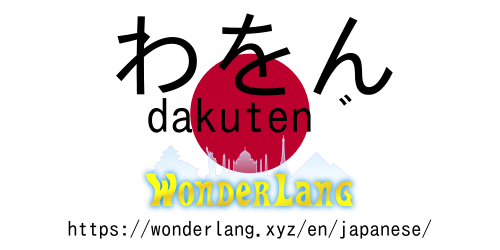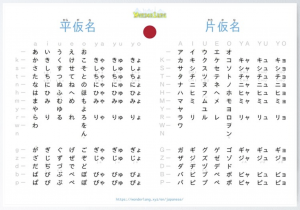Hello Everyone,
Here is the last hiragana lesson, and we will learn the hiragana: わ, を and ん, as well as the use of the dakuten ◌゙ to derive new sounds. Let’s go!
| Amazon.com | 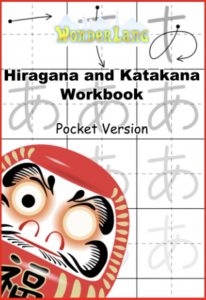 |
Amazon.ca |
If you want a refresher, do not hesitate to have a look at our previous lessons:
- Hiragana lesson 1 – a, i, u, e, o
- Hiragana lesson 2 – ka, ki, ku, ke, ko
- Hiragana lesson 3 – sa, shi, su se, so
- Hiragana lesson 4 – ta, chi, tsu, te, to
- Hiragana lesson 5 – na, ni, nu, ne, no
- Hiragana lesson 6 – ha, hi, fu, he, ho
- Hiragana lesson 7 – ma, mi, mu, me, mo
- Hiragana lesson 8 – ya, yu, yo and halfwidth -ya, -yu, -yo and tsu-
- Hiragana lesson 9 – ra, ri, ru, re, ro and the handakuten ◌゜ derivates
Now, get your paper and pencil ready!
|
Downloadable content
|
Get the kana poster on WonderLang’s Shop! |
わ
This hiragana is pronounced: [wa]
It has 2 strokes:

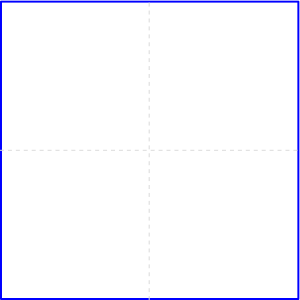
Exercices:
- Write 10 times the character わ in a row.
- Write 5 times the word かわ [kawa] / river /
- Write 5 times the word わさび [wasabi] / wasabi, Japanese custard /
- Write 5 times the word わたし [watashi] / I, me /
を
This hiragana is pronounced: [wo]
Note: Even though this character is normally pronounced [wo], it’s sole use is to serve as a grammatical particle indicating the object complement of a clause, and it is always pronounced [o].
It has 3 strokes:


Exercices:
- Write 10 times the character を in a row.
- Write 5 times the word おちゃ を のむ [ocha o nomu] / drinking tea /
ん
This hiragana is pronounced: [n]
This character is particular as it is the only consonant which isn’t attached to a vowel. Note also that it can sometimes sound like an [m] when before a [b-] or [p-] syllable, like in てんぷら [tempura].
It has 1 stroke:


Exercices:
- Write 10 times the character ん in a row.
- Write 5 times the word まんが [manga] / manga, Japanese comic /
- Write 5 times the word じてんしゃ [jitensha] / bycycle /
- Write 5 times the word すみません [sumimasen] / excuse-me /, both when you are sorry to interrupt someone or when you are apologizing.
Here we are, this was the last hiragana in the list, but you will see that the dakuten brings in quite a few more sounds.
Dakuten ◌゙
As with the handakuten ◌゚, you may already have spotted that some hiragana can be followed by two little strokes (ten ten) on their top right. These small strokes represent the dakuten which role is to create what is called voiced sounds. But where the handakuten came only with the characters in the は line, the dakuten can be used with the characters from 4 different lines and can be really frequently encountered:
Added to か [ka] for instance, the dakuten gives が which is pronounced [ga].
Added to さ [sa] for instance, the dakuten gives ざ which is pronounced [za].
Added to た [ta] for instance, the dakuten gives だ which is pronounced [da].
Added to は [ha] for instance, the dakuten gives ば which is pronounced [ba].
Here is the list of the different characters and their pronunciations:
| か [ka] | が [ga] |
| き [ki] | ぎ [gi] |
| く [ku] | ぐ [gu] |
| け [ke] | げ [ge] |
| こ [ko] | ご [go] |
| さ [sa] | ざ [za] |
| し [shi] | じ [ji] |
| す [su] | ず [zu] |
| せ [se] | ぜ [ze] |
| そ [so] | ぞ [zo] |
| た [ta] | だ [da] |
| ち [chi] | ぢ [ji] (less frequent than じ) |
| つ [tsu] | づ [zu] (less frequent than ず) |
| て [te] | で [de] |
| と [to] | ど [do] |
| は [ha] | ぱ [ba] |
| ひ [hi] | ぴ [bi] |
| ふ [fu] | ぷ [bu] |
| へ [he] | ぺ [be] |
| ほ [ho] | ぽ [bo] |
Exercises:
- Write 5 times the characters がぎぐげご in a row.
- Write 5 times the characters ざじずぜぞ in a row.
- Write 5 times the characters だぢづぜぞ in a row.
- Write 5 times the characters ばびぶべぼ in a row.
- Write 5 times the word ぎょうざ [gyōza] / gyouza, Japanese fried ravioli /
- Write 5 times the word ぜんぶ [zembu] / all, entire /
- Write 5 times the word だいどころ [daidokoro] / kitchen /
- Write 5 times the word じょうず [jōzu] / skillful /
Here we are with this series of lesson. Next time we will be starting learning katakana!
Do not hesitate to share and comment if you liked it! You can find us on Facebook, Twitter, Google+ and Reddit!
Cheers,
Stéphane
Next lesson: Katakana lesson 1: A, I, U, E, O and halfwidth A, I, U, E, O
Visit the WonderLang shop and support my work 🙂
 |
 |
 |
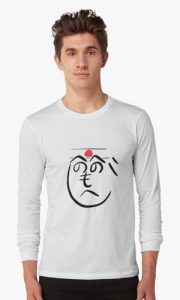 |
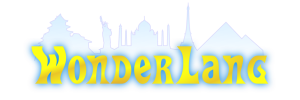 |
|||

